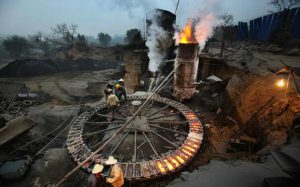The visit of Japanese Prime Minister Shinzo Abe to Washington this week was mainly occupied by reaffirming economic and military ties, but on climate change, it looks unlikely that the long-term US ally will heed a call by the White House for strong ambition.
Despite a joint affirmation this week between the two countries, including comments on climate and low energy, analysts say the signs aren’t good.
Japan is likely to propose a greenhouse gas (GHG) emissions cut of 26% by 2030 from 2013 levels, but the baseline year reflects the aftermath of the 2011 of Fukushima earthquake, when nuclear plants were shut down and coal plants ran at full pelt.
That means that the developed world’s second largest national emitter won’t have to do as much to meet its targets as some other rich countries, and will remain reliant on coal at a time that the EU and US say they are moving towards cleaner burning gas and are rolling out renewables on a much bigger scale.
“Even if Japan was to opt for a 26% cut, it would still be much less ambitious than EU and US targets (which use base years of 1990 and 2005 respectively),” said Nick Mabey, head of climate policy consultants E3G.
Although some developing countries view the EU and US efforts also as unambitious, their proposals are viewed as being broadly in line with aspirational targets to slash GHGs around 80% by 2050 from 1990 levels.
But Japan’s plans are unlikely to put it anywhere near a pathway that scientists warn is required from major emitters if the world is to escape runaway climate change.
“Up to 43 coal-fired power plants are scheduled to be built in Japan, which could account for 25% of electricity supply by 2030, and would account for half of what Japan could emit under the country’s target,” Mabey added in a conference call to publicise a report on Japan's increasingly aloof stance at international climate talks.
That would mean coal's share of the power generation mix would be scarcely changed from the current 25% level .
Analysts say Japan’s lack of ambition matters, and not just because of its large carbon footprint.
The country’s technological prowess is viewed as important in further driving down the cost of environmental technologies and innovations in energy efficiency that might help it and other countries slow, and eventually reverse, growth in GHG emissions.
Japan also has clout as a big funder of energy projects in Asia, but has insisted that some of its green finance commitments be used to build ultra efficient – but still hugely polluting – coal fired power stations.
Vested interests
At home, Japan’s ‘Keidanren’ business federation has a major say in climate and energy policy, meaning highly carbon intensive industries such as power generation, chemicals, construction and metals appear to have trumped demands from the green tech sector for tougher targets.
Moreover, observers point out that the country’s political culture makes it difficult for civil society concerns about Japan’s responsibility for climate change – and the risks that rising sea levels and extreme weather would pose for the island nation – to shape wider policy.
For industry, the struggles to restart the country’s nuclear industry in the aftermath of the Fukushima disaster underline the need to have flexibility to use coal, which is much less expensive to burn than expensive imports of liquefied natural gas.
Japan, which has few fossil fuel resources of its own, could soon import more coal than China, where vast domestic reserves will likely edge out foreign supply and the country’s central government has capped consumption of the highly-polluting fuel.
But observers say that Japan has options to be much more ambitious in cutting emissions, even without nuclear power, such as harnessing much more of its wind resources to match its considerable efforts in expanding the reach of solar power.
IGES, a Japanese think tank, says Japan could also do much more in promoting energy efficiency, particularly in the short-term, and invest in carbon capture and storage to slash C02 emissions from coal-fired power plants.
These measures combined could deliver GHG emissions cuts of 25% below 1990 levels and a 31% reduction from a 2013 baseline, without nuclear, IGES says.
Grid block
And if Japan was to restart many of its reactors – and build new ones – then the cuts could be almost 40% below 1990 levels, it adds.
For some policymakers, major new subsidies for low-carbon energy would be excessively costly as the country looks to emerge from decades of sluggish economic growth, while wind and solar are seen as unsuitable to provide baseload power supply.
For the share of renewables capacity to grow sharply, Japan would need to upgrade its inefficient grid and reform its electricity market, moves that would likely be hindered by the country’s decentralised power industry.
But the perception that a relatively rich and technologically-advanced country such as Japan is using the Fukushima disaster to slack off on tackling climate change is likely to go down badly at UN climate talks.
The process resumes next month ahead of the Paris summit in December and needs to build momentum over the next months if a meaningful climate deal is to emerge by the end of the year.
“If Japan is seen to be doing relatively little then it could be seen as a drag on the entire process,” says E3G’s Mabey.








